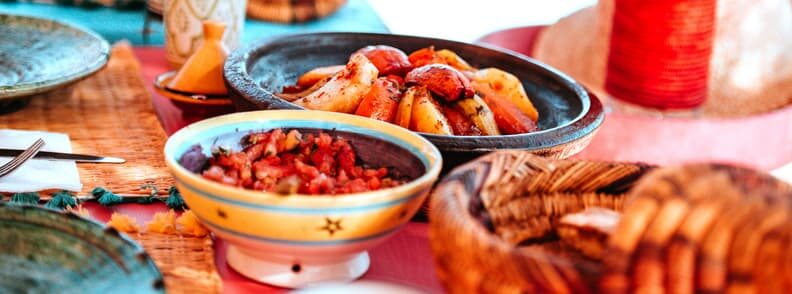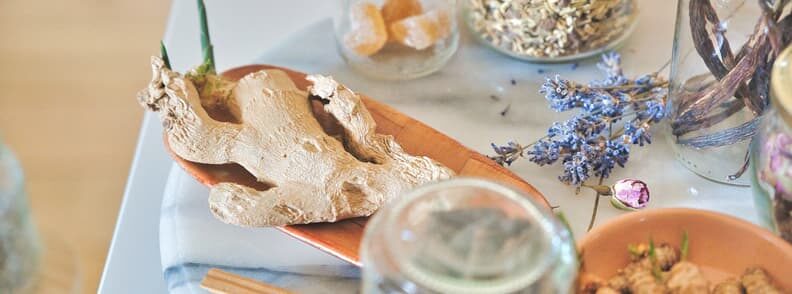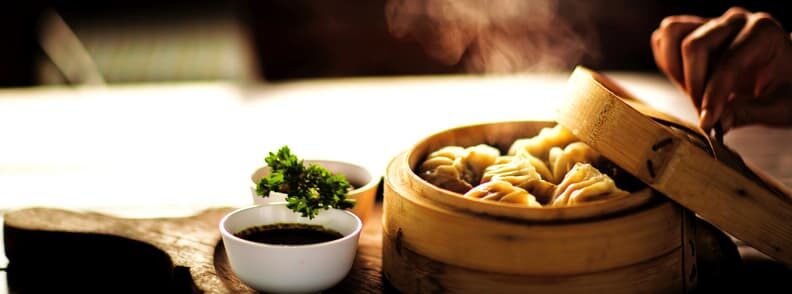Adaptogenic menus are set to be one of the biggest travel trends this yea, Conde Nast Traveller reports. Adaptogens are powerful herbs and mushrooms that can help your body combat stress, anxiety, and fatigue, and improve overall well-being. Adaptogenic lattes, teas, and smoothies are available around Los Angeles, while Sweeties bar at The Standard Hotel in London serves up adaptogenic cocktails (Gold Dust Woman, in particular, features turmeric).
No matter where in the world you travel, sampling the local cuisine is a must, and one of the most memorable parts of any trip. And, it’s only natural to start longing for your new favorite travel dishes once you return home. Fortunately, with a little forethought and preparation, you can easily recreate travel food at home in a few simple steps.

Pay attention on your travels
If you want to recreate the dishes you experienced on your travels back home, it’s important to pay attention to the various dishes you sample and start your food-related research while you’re still on the road. This can be as simple as visiting local bookshops to hunt down English cookbooks or authentic recipes, but you can even go a step further and sign up for cooking classes.
You should also make an effort to bring key ingredients home with you – particularly if you’ve never heard of them before. Spice blends, in particular, typically form the backbone of certain dishes, and by purchasing them locally, you can make sure you’re getting the real deal.
For example, Za’atar is a Middle Eastern spice mix that adds a nutty, herby flavor and crunch to dishes. Za’atar’s exact composition can vary depending on where you are in the world, but it usually consists of thyme, oregano, sumac, and toasted sesame seeds.
Alternatively, Chimichurri is commonly featured in Argentinian and Uruguayan cuisine. Made with either fresh or dried herbs, Chimichurri typically includes parsley, cilantro, lemon juice, olive oil, and garlic, and can be used as a marinade, ingredient, or condiment.
If you have any food-related questions, feel free to ask the locals – they’ll be happy to recommend great local food, as well as help you source any ingredients or recipes you’ve fallen in love with. Then, once you’re back home, you’ll have a far easier time recreating your favorite dishes since you’re equipped with authentic recipes, key ingredients, and first-hand knowledge of how to prepare the food.

Have fun in the kitchen
Before you start getting to work in the kitchen, the first step is to make sure you have all the necessary ingredients for the dish to hand. In some cases, you may be able to substitute a missing ingredient easily for something else, but this doesn’t always work successfully. It’s therefore important you’re ready with all the correct ingredients before you begin cooking.
Similarly, you should take care to follow the recipe closely. Sometimes, missing a step – even a small one – can dramatically impact the final dish. So, take time to read through the recipe once before you start cooking, so you know what to expect. That said, feel free to use your intuition as you cook. For example, taste testing as you go is key. You may find you need to adjust the seasonings so the dish ends up just as you like it.
If you have children, you can also get them involved in recreating your favorite dishes from abroad. Teaching your children to cook isn’t just a fun bonding experience, it also offers a host of benefits, including aiding their time-management and planning skills, helping them learn about common kitchen hazards, and strengthening their confidence and self-esteem. Cooking has also been proven to help children develop better dietary habits and make healthier food choices as they grow up.
First, you’ll need to invest in a few simple pieces to help your children stay safe in the kitchen. A step stool, for example, can help older children reach the counter, while non-slip bowls are also useful to ensure stability when your children are mixing, mashing, or whisking. And, don’t forget aprons! Cooking with little ones can be messy, and aprons can help protect clothing from splashes and stains.

Secure a local supply of ingredients
No matter how excited you are about your authentic spice supply, it won’t last forever – which means you should work on finding a local supplier. Keep in mind, ethnic dishes are increasingly popular in the United States, and exotic spices, therefore, aren’t as difficult to find now as they once were. You may be surprised at what you can find in your local supermarket. So, start your spice search at your regular go-to stores. If you don’t find what you’re looking for, you can then search online for your nearest exotic spice stores and specialty food stores.
Find alternative ingredients
Exotic ingredients can infuse your cooking with a unique depth of flavor. Achiote paste, for example, is commonly used in Central America and Mexico; it’s a salty bittersweet paste made from annatto seeds, vinegar, salt, garlic, and peppery spices. Or, if you visit Korea, you’ll likely come across gochujang: a popular red chili paste that’s salty, sweet, and spicy all at the same time. In addition to red chili powder, gochujang contains powdered fermented soybeans, glutinous rice powder, and salt. Black garlic is another ingredient big in Asia; it’s essentially aged garlic that packs a slightly sweet and tangy taste and creamy texture.
Yet, no matter which unique ingredients you encounter on your travels, you’ll find most of them can be substituted with something similar if you can’t lay your hands on the original. For example, Cambodian galangal root (also known as blue ginger) can be substituted with ginger just fine. And, you can also easily make your own spice mixes if needed. For example, Moroccan Ras el Hanout spice mix is made with a combination of common, everyday spices you probably already have in the kitchen cupboard: paprika, turmeric, ginger, coriander seeds, allspice, chili, cumin seeds, cinnamon, and cardamom.
Join a local community
You may be back home, but you’re still part of a vibrant, multicultural country. And, you may not be too far from a welcoming community that corresponds with the type of cuisine you’re interested in – whether it be Chinese, Italian, Malay, or Japanese, for example. If you’re looking to recreate a Mexican dish, look up your nearest Mexican community.
On the other hand, if you can’t find the right community within traveling distance, look up nearby restaurants that specialize in the type of cuisine you’re after. You can then try asking the restaurant owners and chefs any questions you may have, such as, where do they buy their ingredients and which grocery store has the biggest range.
Traveling is a great opportunity to sample a variety of delicious cuisines and fall in love with new flavors. By paying attention to the food on your travels, securing a local supply of the right ingredients, joining a local community, and having fun in the kitchen, you’ll be able to successfully recreate your favorite travel dishes at home in no time!

Mirela Letailleur is a Romanian travel blogger living in the South of France. She writes on The Travel Bunny travel blog about affordable travel in Europe. Creator of unique free travel guides and local travel expert. Problem solver. Wannabe coffee guru.
After cooking travel dishes at home, check out these foodie guides
Europe’s best food adventure holidays
Eating in Chiang Mai Thailand vs. North America
Delicious coffee map for travelers

